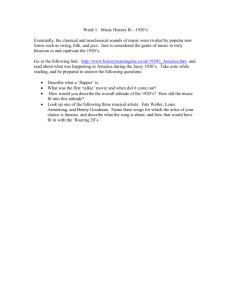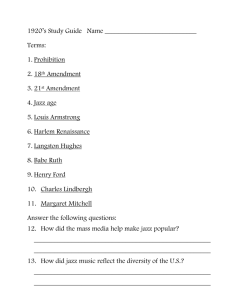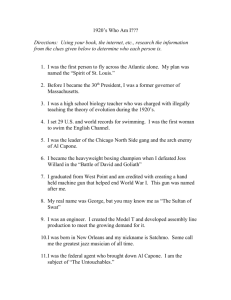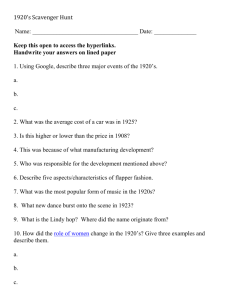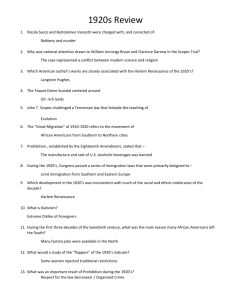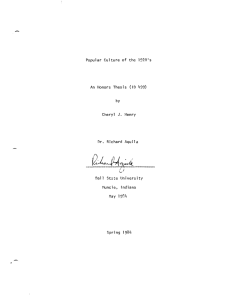Chapter 28 Study Guide
advertisement
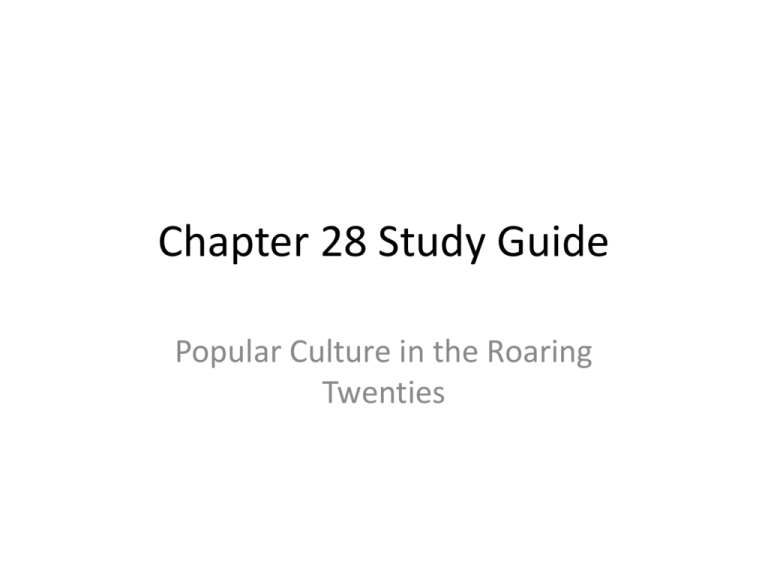
Chapter 28 Study Guide Popular Culture in the Roaring Twenties 1 • Causes of consumer culture were increasing amounts of radio and print advertising create desire; greater availability of new products: electrification of homes spurred new appliances; frequent changes of style made to induce consumers to buy often. • Effects of the consumer culture were the invention of new products cost more than old, prompting the growth of installment buying. 2 Air transportation: Technological developments from World War I led to flights for entertainment and mail delivery, which led to the growth of commercial aviation; new technology developed by Henry Ford made safer, more powerful planes, boosting passenger flights; people could travel farther and faster. Automobiles: Henry Ford made cars more affordable and plentiful; cars gave women and teens new freedom; ended the isolation of farmers; changed where people lived as suburbs grew; led to more paved roads; new businesses sprang up to serve the needs of car travelers. 3 The Roaring Twenties was the American decade of the 1920’s which represented a change in culture and is exemplified by a celebratory lifestyle. As newspapers, magazines, radios, and movies became more accessible, popular culture became more common across the nation, causing regional differences to fade. Radio made news more immediate, and movies exposed Americans to new fashions and a loosening of the rules of social behavior. The Charleston a popular dance in the 1920’s which began as an African American folk dance in the South and eventual came to represent a decade in American history. 4 • The passage of the Nineteenth Amendment in 1920, the rise of organizations such as the League of Women Voters, a grassroots organization formed to educate voters on the public issues in education, and the election of women to public office gave women new ways to participate in politics. In addition, women during this time became increasingly active in health care reform and the fight for equal rights. As a result, the 1920’s brought expanded educational and job opportunities and increased incomes for women. Many young women rebelled against old customs. They fought for changes in the law such as the Equal Rights Amendment which was an attempt to pass a constitutional amendment to guarantee equal rights based on gender. 5 The origins of Jazz were in Blues and ragtime, which grew out of African rhythms, European harmonies, African American folk music and work songs, and 19th Century American band music and instruments. Jazz began in New Orleans and spread by boat and railroad to other cities. Night clubs an radio helped the spread, and jazz became the first uniquely American music to be popular around the world. Musicians: Duke Ellington, Benny Goodman, Jelly Roll Morton, Bessie Smith, Louis Armstrong. It marked a period referred to as the Jazz Age a term used describe the 1920’s it represented a new form of music which focused on an improvisational nature. 6 • Harlem Renaissance A term used describe the 1920’s it represented a new form of music which focused on an improvisational nature. Harlem Renaissance writers and white writers of the 1920’s were critical of traditional American values. African American writers explored what it meant to be black in America and expressed the longing for equality. Examples: Langston Hughes, James Weldon Johnson, Zora Neal Hurston. The Lost Generation reacted to the brutality of World War I and growing consumer culture, expressing the rootless feelings of young people after the war. Examples: Gertrude Stein, e. e. Cummings, Ernest Hemmingway, F. Scott Fitzgerald, Jon Dos Passo, Sherwood Anderson. Other writers also found fault with American life, critiquing the moral emptiness of the upper class, the narrowness of life in small town America, and the tragedy of everyday life. They were called the Lost generation a term used to describe those in the 1920’s who felt a sense of disillusionment(sadness) created by the horrors of WWI. Examples were Sinclair Lewis, Eugene O'Neal. 7 • Edward Hopper expressed a sense of loneliness and isolation in his work. Rockwell Kent created moody scenes of nature. Georgia O'Keefe reflected the wide open West and reacted to the speeding up of life by painting huge paintings of small things that peopl rarely took time to see in detail.
